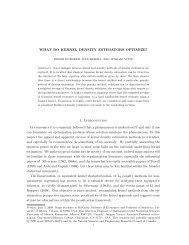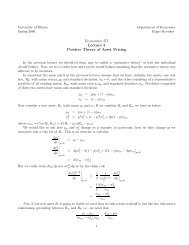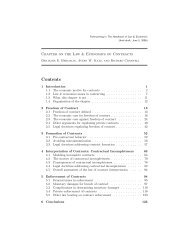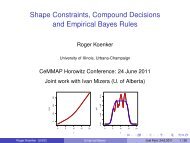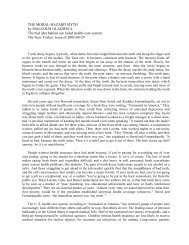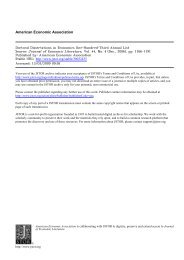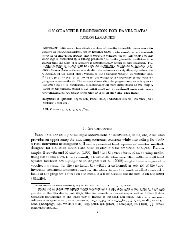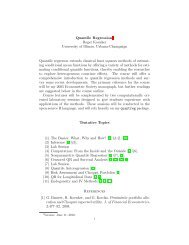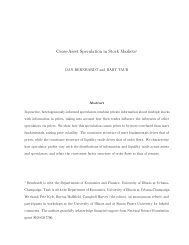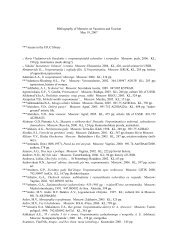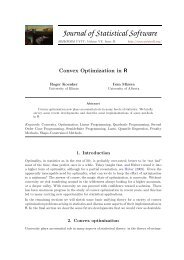1. Introduction - Econometrics at Illinois - University of Illinois at ...
1. Introduction - Econometrics at Illinois - University of Illinois at ...
1. Introduction - Econometrics at Illinois - University of Illinois at ...
You also want an ePaper? Increase the reach of your titles
YUMPU automatically turns print PDFs into web optimized ePapers that Google loves.
Roger Koenker and Zhijie Xiao 29for each \slope" coecient. In eect, this approach replaces the m<strong>at</strong>rix standardiz<strong>at</strong>ionused for the joint test by a scalar standardiz<strong>at</strong>ion. The martingale transform<strong>at</strong>ionis then applied just as in the previous case. Now, because there is no m<strong>at</strong>rix standardiz<strong>at</strong>ionthe original labeling <strong>of</strong> the coordin<strong>at</strong>es is meaningful. In Table 6.1 wereport the test st<strong>at</strong>istics,K ni =supj~v ni () , ~v ni ( 0 )j= p 1 , 02Tfor each <strong>of</strong> the covari<strong>at</strong>es. Eects for the 5 quarters <strong>of</strong> entry are not reported. Thecritical values for these coordin<strong>at</strong>ewise tests are <strong>1.</strong>923 <strong>at</strong> .05, and 2.420 <strong>at</strong> .01, as givenin Appendix B, so the tre<strong>at</strong>ment, race, gender and age eects are highly signicant.Variable Loc<strong>at</strong>ion Scale Shift Loc<strong>at</strong>ion ShiftTre<strong>at</strong>ment 5.41 5.48Female 4.47 4.42Black 5.77 22.00Hispanic 2.74 2.00N-Dependents 2.47 2.83Recall Eect 4.45 16.84Young Eect 3.42 3.90Old Eect 6.81 7.52Durable Eect 3.07 2.83Lusd Eect 3.09 3.05Joint Eect 112.23 449.83Table 6.<strong>1.</strong> Tests <strong>of</strong> the Loc<strong>at</strong>ion-Scale-Shift HypothesisAlso reported in Table 6.1 are the corresponding test st<strong>at</strong>istics for the pure loc<strong>at</strong>ionshifthypothesis. Not surprisingly, we nd th<strong>at</strong> the more restrictive hypothesis <strong>of</strong>constant i () eects is considerably less plausible than the loc<strong>at</strong>ion scale hypothesis.The joint test st<strong>at</strong>istic is now, 449.83, with .01 critical value <strong>of</strong> 16.00, and all <strong>of</strong>the reported covari<strong>at</strong>es eects are signicant <strong>at</strong>level .05, with the exception <strong>of</strong> thehispanic eect.7. ConclusionWh<strong>at</strong> should we conclude from this exercise? The linear loc<strong>at</strong>ion shift and loc<strong>at</strong>ionscaleshift models are very elegant and convenient abstractions for many st<strong>at</strong>isticalpurposes. However, they also clearly place very stringent restrictions on the way th<strong>at</strong>covari<strong>at</strong>es are permitted to inuence the conditional distribution <strong>of</strong> the response variable.In our unemployment dur<strong>at</strong>ion applic<strong>at</strong>ion the loc<strong>at</strong>ion-scale shift hypothesismay be viewed as a generalized form <strong>of</strong> the familiar acceler<strong>at</strong>ed failure time model inwhich the scale <strong>of</strong> the response distribution responds linearly to the covari<strong>at</strong>es. This



